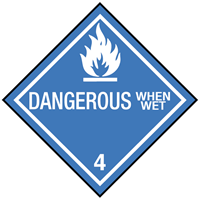
 Print
Print
Chemical Datasheet
FERROSILICON |


|
Chemical Identifiers
| CAS Number |
UN/NA Number |
DOT Hazard Label |
USCG CHRIS Code |
|
|
|
- Dangerous When Wet
- Poison
|
|
| NIOSH Pocket Guide |
International Chem Safety Card |
|
none
|
none
|
NFPA 704
data unavailable
General Description
A solid alloy of iron and silicon. Used to add silicon to iron and steel. Ferrosilicon is an odorless, crystalline solid metal. It is flammable and can react explosively with oxidizing materials. In the presence of moisture or water it may emit toxic and explosive fumes. It is used in magnesium processing.
Hazards
Reactivity Alerts
- Strong Reducing Agent
- Water-Reactive
- Pyrophoric
Air & Water Reactions
Flammable. Reacts with water or moisture in the air to form flammable hydrogen gas. The heat created by the reaction may be sufficient to ignite the hydrogen generated.
Fire Hazard
Special Hazards of Combustion Products: Irritating vapors and toxic gases may be formed when involved in fire. (USCG, 1999)
Health Hazard
Exposure can cause irritation of eyes, nose and throat. Toxic if inhaled or ingested. (USCG, 1999)
Reactivity Profile
Metals, such as FERROSILICON, are reducing agents and tend to react with oxidizing agents. Their reactivity is strongly influenced by their state of subdivision: in bulk they often resist chemical combination; in powdered form they may react very rapidly. Thus, as a bulk metal it is somewhat unreactive, but finely divided material may be pyrophoric. The metal reacts exothermically with compounds having active hydrogen atoms (such as acids and water) to form flammable hydrogen gas and caustic products. The reactions are less vigorous than the similar reactions of alkali metals, but the released heat can still ignite the released hydrogen. Materials in this group may react with azo/diazo compounds to form explosive products. These metals and the products of their corrosion by air and water can catalyze polymerization reactions in several classes of organic compounds; these polymerizations sometimes proceed rapidly or even explosively. Some metals in this group form explosive products with halogenated hydrocarbons.
Belongs to the Following Reactive Group(s)
- Metals, Elemental and Powder, Active
Potentially Incompatible Absorbents
No information available.
Response Recommendations
Isolation and Evacuation
Excerpt from ERG Guide 139 [Substances - Water-Reactive (Emitting Flammable and Toxic Gases)]:
IMMEDIATE PRECAUTIONARY MEASURE: Isolate spill or leak area in all directions for at least 50 meters (150 feet) for liquids and at least 25 meters (75 feet) for solids.
SPILL: Increase the immediate precautionary measure distance, in the downwind direction, as necessary.
FIRE: If tank, rail tank car or highway tank is involved in a fire, ISOLATE for 800 meters (1/2 mile) in all directions; also, consider initial evacuation for 800 meters (1/2 mile) in all directions. (ERG, 2024)
Firefighting
Fire Extinguishing Agents Not to Be Used: Do not use water. Dangerous when wet.
Fire Extinguishing Agents: Dry chemical, alcohol foam, or carbon dioxide. (USCG, 1999)
Non-Fire Response
Excerpt from ERG Guide 139 [Substances - Water-Reactive (Emitting Flammable and Toxic Gases)]:
ELIMINATE all ignition sources (no smoking, flares, sparks or flames) from immediate area. Do not touch or walk through spilled material. Stop leak if you can do it without risk. DO NOT GET WATER on spilled substance or inside containers. Use water spray to reduce vapors or divert vapor cloud drift. Avoid allowing water runoff to contact spilled material. FOR CHLOROSILANES, use alcohol-resistant foam to reduce vapors.
SMALL SPILL: Cover with DRY earth, DRY sand or other non-combustible material followed with plastic sheet to minimize spreading or contact with rain. Dike for later disposal; do not apply water unless directed to do so.
POWDER SPILL: Cover powder spill with plastic sheet or tarp to minimize spreading and keep powder dry. DO NOT CLEAN-UP OR DISPOSE OF, EXCEPT UNDER SUPERVISION OF A SPECIALIST. (ERG, 2024)
Protective Clothing
Wear protective clothing to prevent contact with dust. Use approved respirator to protect against dust. (USCG, 1999)
DuPont Tychem® Suit Fabrics
No information available.
First Aid
Get medical attention.
INHALATION: Remove to fresh air. If breathing has stopped, give artificial respiration. If breathing is difficult, give oxygen.
EYES: Flush with water for at least 15 min., lifting lids occasionally.
SKIN: Remove contaminated clothing and shoes. Flush with water. (USCG, 1999)
Physical Properties
Flash Point: data unavailable
Lower Explosive Limit (LEL): data unavailable
Upper Explosive Limit (UEL): data unavailable
Autoignition Temperature: data unavailable
Melting Point: data unavailable
Vapor Pressure: data unavailable
Vapor Density (Relative to Air): data unavailable
Specific Gravity:
5.4
(USCG, 1999)
- Denser than water; will sink
Boiling Point: data unavailable
Molecular Weight: data unavailable
Water Solubility: data unavailable
Ionization Energy/Potential: data unavailable
IDLH: data unavailable
AEGLs (Acute Exposure Guideline Levels)
No AEGL information available.
ERPGs (Emergency Response Planning Guidelines)
No ERPG information available.
PACs (Protective Action Criteria)
No PAC information available.
Regulatory Information
EPA Consolidated List of Lists
No regulatory information available.
CISA Chemical Facility Anti-Terrorism Standards (CFATS)
No regulatory information available.
OSHA Process Safety Management (PSM) Standard List
No regulatory information available.
Alternate Chemical Names
- FERROSILICON
- FERROSILICON, [FLAMMABLE SOLID]
- FERROSILICON, [WITH >= 30% BUT <= 70% SILICON]



 Print
Print

